Let’s take a break from our regularly scheduled programming for RVs to look at their close cousin – utility trailers!
Decking is a critical part of your utility trailer. It holds your stuff, seals against water, prevents animal intrusion, and strengthens your frame.
Your choice of decking or flooring will vary by trailer type.
- For instance, a lightweight lawn trailer may use expanded steel mesh. It’s lightweight and doesn’t hold water.
- But a utility trailer may prefer 2×8 pressure-treated lumber planks to handle heavier loads.
- And a cargo trailer may prefer a ultralight plywood or composite for a water- and insect-proof permanent floor.
There’s not one single best choice for your trailer decking or flooring. Let’s look at the pros and cons of some common options for the DIY builder.
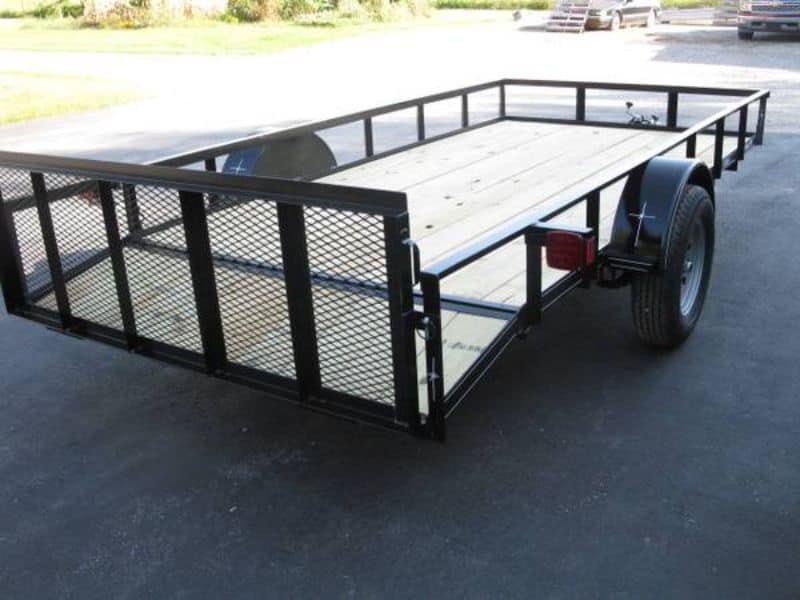
Expanded Metal Decking
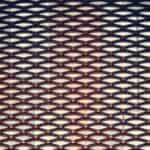
Expanded metal decking (i.e. steel mesh) is commonly used on small utility trailers and ATV trailers. If you’re looking for a lightweight, all-purpose trailer decking for moving equipment and not mulch, this is a great material. But not so great for heavy-duty uses, which can cause the mesh to sag or tear.
Expanded metal is usually made from unfinished steel, although it is also available in galvanized steel, stainless steel, and aluminum.
Not all mesh patterns are the same! The thickness (gauge) of the metal (i.e. strand width and strand thickness), the alloy, the temper, and the open size all affect its strength properties. #9 gauge is the recommended minimum size.
Commercial builders normally lay the mesh diamonds sideways on the trailer frame for the best yield. But laying the sheet so the long axis of the diamonds is oriented parallel with the main rails may stiffen the floor.
Most builders will choose to weld metal mesh directly to the frame. However, it can be mechanically fastened to a trailer frame using self-drilling screws with oversized fender washers.
Because expanded metal isn’t stiff, by its nature, the crossmembers will need to be closer together (20-24 inches) to prevent sagging or tearing. The material is best used for light-duty trailer decking or on ramps and sides.
One of the big benefits to mesh decking is the ease of hooking. You can hook small ratchet straps and bungee straps almost anywhere!
Sheet & Diamond Plate

Rather than expanded metal, you might choose to use solid metal sheet or plate. Because metal sheet is so heavy, this option is more common on aluminum trailers than steel ones.
The obvious benefit of sheet or plate is that it’s continuous. No water, no insects. It’s great for hauling much or paint cans.
Some builders opt to install solid diamond plate on the floor. This material is available in unfinished steel, aluminum, or stainless steel. It’s quite expensive! It’s rare to see solid diamond plate on a small trailer; it’s typically reserved for industrial transportation equipment. However, you can purchase diamond plate retail in thicknesses up to 1″ thick (which is a whopping 42 pounds per square foot)!
However, the usual practice for small trailers is to lay thin stamped diamond plate sheet (usually 0.032″ to 0.065″ thick) atop an already finished floor, such as 2x lumber. This thinner version of diamond plate is often called “tread plate.”
Diamond plate sheet is often preferred by builders for its anti-slip properties. However, unlike other anti-skid finishes, such as rough rubber, diamond plate can be easily swept and cleaned.
Extruded Decking
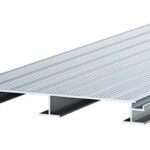
For a heavy-duty floor, you can opt to install rectangular tube or metal extrusions similar to installing plywood lumber planks. Because of the weight of metal, this option is more common on aluminum trailers, particularly car haulers.
The heavier-duty option is to install rectangular metal tubes, such as 1×4 HSS sections. As you can imagine, this is extremely heavy and bulky!
So the more common choice is to install interlocking extrusions that assemble, similar to installing laminate flooring. With extrusion systems, you can choose the strength and surface of your desired decking. For instance, you can choose an aggressive serrated edge for maximum anti-skid performance.
If you like the idea of interlocking extrusions but wish they had drainage, you can order perforated decking instead.
Plywood or Dry OSB
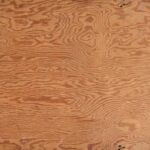
Plywood is a common flooring option for RVs, cargo trailers, and lightweight, light-duty utility campers.
OEMs have access to “jumbo-sized” sheets of plywood or OSB that can cover an entire trailer frame. But as a DIY builder, you’ll probably be using 4×8, 4×9, or 5×10 sheets. Expect to pay a 50-100% markup premium per square foot for anything bigger than a 4×8.
The typical thickness for a plywood floor is ¾”. You can increase to 1” for greater strength or ⅝” for lightweight uses, like an homemade camper trailer. Don’t go any thinner than ⅝”!
It is best to use pressure-treated SYP plywood. And remember to use galvanized fasteners when installing pressure-treated plywood. Pressure-treated wood is extremely corrosive! It requires approved fasteners and should NOT be put in direct contact with bare aluminum. We recommend using a plastic flashing tape between the aluminum frame and pressure-treated flooring. These tapes are often used for high-end residential window flashing and floor joists.
While you can coat the edges and exposed faces of other construction plywoods, such as BCX plywood, the work is extensive and expensive. Most DIY waterproofing methods, such as exterior paints, roofing tar, elastomeric coatings, will require annual maintenance. Epoxy coatings can last the lifetime of the trailer, but by the time you pay for an epoxy, you would have saved money just buying pressure-treated plywood!
But if you do choose to use these products, prime and paint all sides, including the bottom and all edges, whether field-cut or factory.
Marine plywood can also be used, but it is quite costly! It is made without interior core voids, which prevents the plywood from rotting from the inside out. Like exterior-rated plywood, it should be painted, stained, or otherwise protected.
The only reasonable justification for choosing BCX or marine-grade plywood over pressure-treated plywood is if you’re building a camper with living quarters and don’t want the chemical exposure.
P.S. In recent years, “dry OSB” products by various manufacturers such as Huber Woods Advantech and Georgia Pacific Dry Max have begun to compete with exterior and marine plywoods. However, these products are also not intended for lifetime outdoor exposure and can swell, disintegrate or lose strength when subjected to freeze-thaw evaporative moisture cycles.
Rubber Decking
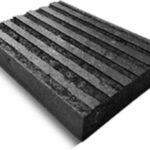
Common in horse and livestock trailers, rubber decking offers some unique advantages over wood or steel.
- It is impervious to most fluids, such as water, urine and fuel.
- It dampens and cushions shock and vibration.
- Excellent traction and slip-resistance, even when wet.
The downsides of rubber planking decking are the cost and the weight. Rubber planks generally weigh 4-6 lb/ft. Even on a 6×12 cargo trailer, a solid rubber floor could weigh as much as 432 pounds! If you’re carefully watching GVW or GVWR, a dense rubber floor may not be your best option.
With that said, nothing quite beats rubber for durability and ease of maintenance. It doesn’t rot. It doesn’t require refinishing. You can clean it with a pressure washer. Besides the weight and the cosmetics (and the odiferous smell in hot weather), there’s not much to dislike about rubber decking!
Composite Panels
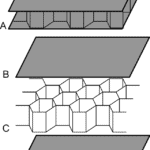
In the past 10 years, composite materials have absolutely stormed the high-end trailer market. You might be interested in using them for your enclosed cargo trailer or homemade camper.
Most composite floors are also known as “sandwich panels,” because they are generally made of two structural skins and a non-structural core, such as foam or honeycomb.
Composite floors are extremely lightweight and, quite often, waterproof. Commercial examples include:
- Transonite
- TransCore
- Havco
Working with composite floors isn’t always easy. They are designed for distributed loads, not point loads. Bolts can easily crush the faces, and the edges cannot retain any mechanical fasteners.
Fair warning: Building ultralight structures requires careful attention to dynamic stresses and point loading, both of which are beyond the scope of this post. If you’re new to working with composite sandwich panels, we advise not making this your first project!
Note: I am NOT referring to composite decking boards, also sold as 4/4 or 5/4 poly lumber for outdoor decks. Plastic decking boards, like Trex, have no reason being installed on a utility trailer. They are heavy, prone to damage, likely to expand, and will warp under high loads.
Wood or Lumber

Lumber has been the mainstay of utility trailer decking for many years – and for good reason! It’s extremely strong, relatively lightweight, affordable, easy to maintain, and easy to replace.
What’s the best wood species for trailer decking?
Popular choices from home improvement stores include pressure-treated Southern Yellow Pine or Douglas fir, both of which are naturally rot-resistant woods.
Avoid SPF or cottonwood lumber, which is not mold-resistant.
On a premium trailer, you might find Apitong (Keruin) or Angelim Pedra, often sold as shiplap flooring. If you’re using your trailer to haul your restored 1967 Chevrolet Chevelle, may as well have the trailer to go with it! This wood is the best of the best, often used for heavy-duty semi-truck haulers.
Other premium options include Purpleheart and rough Oak. These wood species have incredible weight-bearing strength. Oak is one of the only decking materials recommended for use with tracked equipment such as skid steer loaders and excavators.
What’s the best size of lumber for trailer decking?
If you’re purchasing finished planks, the minimum size should be 2×6, although most trailer decks use 2×8 or 2×10 boards. Boards 2×6 or smaller may warp, bow, cup or crown more easily!
Whether you’re using pressure-treated plumber or not, you should finish the wood to increase water- and UV-resistance. You can use a simple deck and siding stain, which can be regularly and easily reapplied. Or you can use an exterior acrylic or oil-based paint. However, paint forms a film atop the wood rather than penetrating stain, which soaks into the surface.
Be sure to check the manufacturer’s instructions before coating pressure-treated plywood. Some require the pressure-treated wood to dry for several weeks to several months before staining.
Hint: If you want more bending strength than a typical 2×8, why not order rough-sawn 2×8’s? These planks are a full 8/4 (approximately 2”) thick rather than the finished 1.5” of dimensional lumber. Just remember to account for the extra half-inch of thickness.
Blackwood Lumber

Blackwood is a wooden lumber product with rubber infused to the top of each board. It’s an incredibly durable product, and one of the few rubberized products that can withstand the abrasion of something like a tracked skid steer. Unlike diamond plate, blackwood doesn’t lose its friction when wet.
Blackwood isn’t a very old product. The first truckload of Blackwood was shipped out to PJ Trailers in May of 2014. Blackwood is now available online at their store.
Image courtesy of Blackwood Lumber.
Leave a Reply